Smith, John (SCC Newsletter December 2002)
John Smith
A RARE ARTIST IN THE JOHN MIERS' MODE.
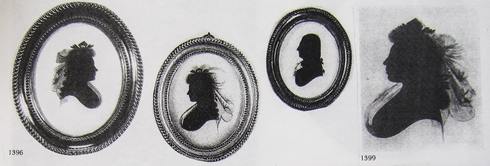 Before Mrs. McKechnie's Book was published very little had been written about this artist by any writer on silhouettes. Mrs. N. Jackson in her Dictionary had two entries on him and had not linked the two. One entry referred to J. Smith a pearl & hair worker and the other referred to T. Smith a painter of silhouettes - both from Edinburgh. Mrs. McKechnie made the link between the two after researching the Post Office Directories for the area. She established that the artist was called JOHN Smith and that he had been a pearl & hairjewellery worker before he started painting silhouettes in 1788. Peggy Hickman in The Art of Silhouette had a small entry on him - likewise John Woodiwiss in British Silhouettes and Arthur Mayne in British Profile Miniaturists. These authors accepted that he had been a pupil of John Miers and they generally regarded his work as derivative and lacking in flair. Arthur Mayne was the most dismissive describing him as a "faithful copyist" lacking individuality! John Woodiwiss, a more discerning writer agreed that he lacked Miers' genius and his standards varied considerably but he regarded some of his likenesses as brilliant. Mrs. McKechnie states that there is no evidence in her view that John Smith was a pupil of Miers.
Before Mrs. McKechnie's Book was published very little had been written about this artist by any writer on silhouettes. Mrs. N. Jackson in her Dictionary had two entries on him and had not linked the two. One entry referred to J. Smith a pearl & hair worker and the other referred to T. Smith a painter of silhouettes - both from Edinburgh. Mrs. McKechnie made the link between the two after researching the Post Office Directories for the area. She established that the artist was called JOHN Smith and that he had been a pearl & hairjewellery worker before he started painting silhouettes in 1788. Peggy Hickman in The Art of Silhouette had a small entry on him - likewise John Woodiwiss in British Silhouettes and Arthur Mayne in British Profile Miniaturists. These authors accepted that he had been a pupil of John Miers and they generally regarded his work as derivative and lacking in flair. Arthur Mayne was the most dismissive describing him as a "faithful copyist" lacking individuality! John Woodiwiss, a more discerning writer agreed that he lacked Miers' genius and his standards varied considerably but he regarded some of his likenesses as brilliant. Mrs. McKechnie states that there is no evidence in her view that John Smith was a pupil of Miers.
It is true that Miers was working in Edinburgh from October 1786 and the autumn of 1788 and she suggests that the two men probably came into contact working together over jewellery pieces. Smith doing the hair & pearl for Miers' jewellery settings. During this collaboration Smith decided he could do the painting as well! This seems a plausible account - especially as Smith only started producing silhouettes in 1788 just at the time Miers was leaving Edinburgh. At the time Smith had other competitors in the City -namely Bruce & Houghton - the former was also a jeweller & frame maker. It seems that Smith worked for about six years painting silhouettes on plaster and possibly reducing these for brooches & lockets - although none have been recorded ta date that can be attributed to him. Why he gave up is not known - no details of his life are known either and his common name makes research difficult. Perhaps the competition became too much for him? However, in spite of everything there are certain features in Smith's work that are peculiar to him which I will describe - although having said this he does work in the Miers' tradition. Not many of his works turn up in the salerooms and I doubt if Collectors have more that one or two works by him if that.
I have photocopied above four silhouettes by John Smith - two are from Mrs. McKechnie's Book (both are numbered) the lady in the middle is ex. Jack
Pollak Collection and the gentleman above her is ex. Martin Willcocks Coll.
JOHN SMITH CONT'D
PROFILES OF GENTLEMEN.
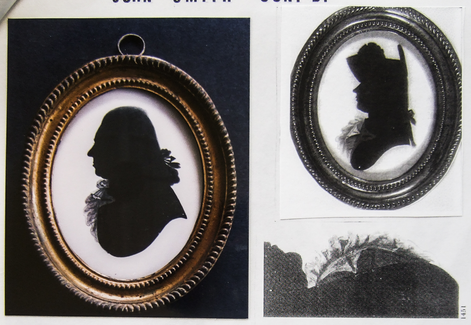 Above on the left is a photograph of a young gentleman - he belongs to a Member of the SCC and was purchased at the Denys Cowell Sale in October. He is a very nice example of Mr. Smith's work and illustrates well the points I want to make about his style. Note the painting of his shirt frill and in particular the painting of the lapel of his frock coat in thinned pigment. The 'treatment' of the lapel seems to be unique to Mr. Smith. The gentleman on the right above has been photocopied from Peggy Hickman's Sale catalogue. This Sale took place at Christie's, South Kensington on 12th.May 1993. He is very smart in his cockaded hat. He is also illustrated in Mrs. McKechnie's Book, but the reproduction does not show that he has also a lapel painted in a thinned pigment against the main body of the silhouette. In addition he shows another characteristic of Mr. Smith's style - his waistcoat (and frill) is painted in a thinned pigment outside the main body of the silhouette. This is shown in greater detail in the photocopy of the enlargement from the Book. His bust-line terminations are the usual cavity/convexity type with a definite plunge to the front.
Above on the left is a photograph of a young gentleman - he belongs to a Member of the SCC and was purchased at the Denys Cowell Sale in October. He is a very nice example of Mr. Smith's work and illustrates well the points I want to make about his style. Note the painting of his shirt frill and in particular the painting of the lapel of his frock coat in thinned pigment. The 'treatment' of the lapel seems to be unique to Mr. Smith. The gentleman on the right above has been photocopied from Peggy Hickman's Sale catalogue. This Sale took place at Christie's, South Kensington on 12th.May 1993. He is very smart in his cockaded hat. He is also illustrated in Mrs. McKechnie's Book, but the reproduction does not show that he has also a lapel painted in a thinned pigment against the main body of the silhouette. In addition he shows another characteristic of Mr. Smith's style - his waistcoat (and frill) is painted in a thinned pigment outside the main body of the silhouette. This is shown in greater detail in the photocopy of the enlargement from the Book. His bust-line terminations are the usual cavity/convexity type with a definite plunge to the front.
FRAMES, PLASTER & GLASS.
All Mr. Smith's silhouettes will be found housed in pressed brass frames. He used convex glass in his frames. In some instances he painted profiles on plaster with a convex surface - so that the work fitted neatly against the glass under which it was framed. Mrs. McKechnie suggested that he probably moulded the shape when wet against the shaped glass. The examples I have photographed in this article do not appear to have this feature but I like to think that the cockaded gent may have such a plaster! His plaster slabs are 3½”x2½” to 3½”x2¾” and the height of his ‘sitters' tend to be about 2" in height or a little more - smaller than those of Mr. Miers.
JOHN SMITH CON’D.
PROFILES OF LADIES.
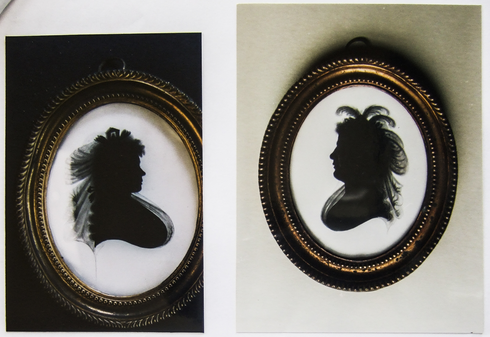 Photographed above are two examples - on the left is from a Collection and on the right is a young lady from the Andrew Collection at Stoner Park. I think both illustrate Mr. Smith's style well. As can be seen he was painting at the time the á la conseiller hairstyle was popular. In this style, curls were worn all over the head with loose tresses of curls down the back of the head. Sometimes hairpieces were added to give extra 'bulk'. Veiling was often worn with this style. Feathers, ribbons and lace were also worn on the head. Diaphanous material was much in fashion and used both for veiling and the buffon to cover the bodice at the front. So fashion gave plenty of scope to the silhouettist if he was able to take the opportunity. Mr. Smith was not always successful but did not do too badly in my view! Mrs.McKechnie took the view that he could not paint woman's flowing curls with the skill of John Miers or Samual Houghton - as a result he showed their hair in a series of scallops and then did some smudging outside the scallops to indicate curls! I feel this is a rather 'harsh' description as the general effect he creates is pleasing. The scallop 'treatment' can be seen clearly on the lady above on the left. Similarly Mrs. McKechinie is critical of his ability to paint the diaphanous material of the head veiling and the buffon to cover the decolletage. The head veiling he shows as terminating in a sharp point below the bust-line termination at the back - this can be seen on both the ladies above and is a feature that can help to attribute Mr. Smith's work. On the positive side his veiling has a lighter touch than that of Mrs. Lightfoot! It seems he also used thick shading at the base of the buffon sometimes crossed by a vertical wavy line - I have not seen examples of this but it is worth noting. Also on the two ladies above I have noted that the buffon does not 'sit' very naturally on the figures!
Photographed above are two examples - on the left is from a Collection and on the right is a young lady from the Andrew Collection at Stoner Park. I think both illustrate Mr. Smith's style well. As can be seen he was painting at the time the á la conseiller hairstyle was popular. In this style, curls were worn all over the head with loose tresses of curls down the back of the head. Sometimes hairpieces were added to give extra 'bulk'. Veiling was often worn with this style. Feathers, ribbons and lace were also worn on the head. Diaphanous material was much in fashion and used both for veiling and the buffon to cover the bodice at the front. So fashion gave plenty of scope to the silhouettist if he was able to take the opportunity. Mr. Smith was not always successful but did not do too badly in my view! Mrs.McKechnie took the view that he could not paint woman's flowing curls with the skill of John Miers or Samual Houghton - as a result he showed their hair in a series of scallops and then did some smudging outside the scallops to indicate curls! I feel this is a rather 'harsh' description as the general effect he creates is pleasing. The scallop 'treatment' can be seen clearly on the lady above on the left. Similarly Mrs. McKechinie is critical of his ability to paint the diaphanous material of the head veiling and the buffon to cover the decolletage. The head veiling he shows as terminating in a sharp point below the bust-line termination at the back - this can be seen on both the ladies above and is a feature that can help to attribute Mr. Smith's work. On the positive side his veiling has a lighter touch than that of Mrs. Lightfoot! It seems he also used thick shading at the base of the buffon sometimes crossed by a vertical wavy line - I have not seen examples of this but it is worth noting. Also on the two ladies above I have noted that the buffon does not 'sit' very naturally on the figures!
JOHN SMITH CONT'D.
PROFILES OF CHILDREN
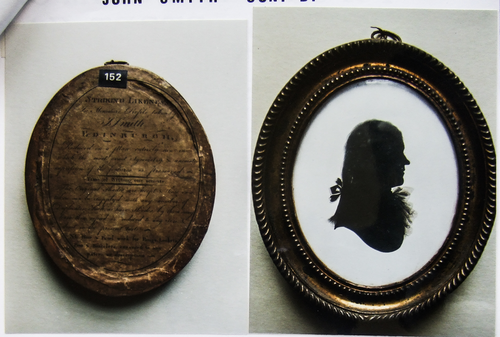 I have not seen any examples but I have photocopied an illustration from the Book at the bottom left of this page.. The child is portrayed in a vert' plain style - Mrs.McKechnie pointing out that Mr.Smith was quite unable to paint the flowing and sometimes wispy hair of children. Perhaps he recognised this and concentrated on their parents!
I have not seen any examples but I have photocopied an illustration from the Book at the bottom left of this page.. The child is portrayed in a vert' plain style - Mrs.McKechnie pointing out that Mr.Smith was quite unable to paint the flowing and sometimes wispy hair of children. Perhaps he recognised this and concentrated on their parents!
HIS LABEL.
There is only one label recorded for J. Smith and I have photographed this on the left above. It backs the silhouette from the Andrew Collection also photographed above. I am sorry that it is not possible to ready the text easily but the wording is recorded in the Book on page 641.0n this label he states that he reduces his silhouettes -presumably for jewellery pieces and ? little red cases. I repeat it is strange that no jewellery by Mr. Smith is recorded - do let me know if any of you have an example!
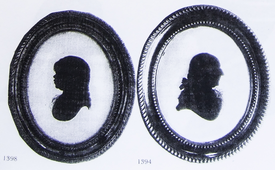 The Andrew's gentleman has a rather showy shirt frill but little else to make one 'shout' that he is by John Smith! The elderly gentleman photocopied on the left is from the Book -again he has an ample shirt frill. Men's shirt frills and women's scalloped curls are the clues!
The Andrew's gentleman has a rather showy shirt frill but little else to make one 'shout' that he is by John Smith! The elderly gentleman photocopied on the left is from the Book -again he has an ample shirt frill. Men's shirt frills and women's scalloped curls are the clues!





